
Precancels of Great Britain
This part of the web site is to consolidate information on GB precancels.
The site has expanded. Click here for a site-map.
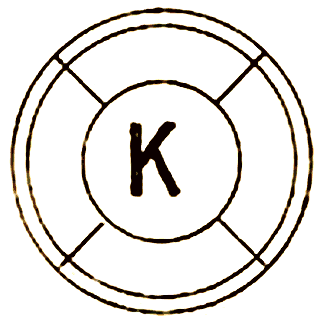
It was at one time suggested that these were pre-cancels because they were so common on W. H. Smith & Son, wrappers.
Analysis of the evidence now forces me to conclude that they were probably applied by inspectors of mail.
We know that they were first issued on 30th April 1860 to the Foreign Branch of the Circulation Department at the London G.P.O., and according to Alcock & Holland they are known used on newspaper wrappers and normal letters, presumably to foreign countries.
My images show use of the first series from at least 29 July 1860 to 20 February 1875, upright from April 1880 to April 1884, and the round T.O.2 from April 1893 to 1894.
One early theory (as held by John Parmenter, 1999) was that the T.O. stood for 'Travelling Office' as short for T.P.O meaning 'Travelling Post Office' but these obliterators were normally allocated the same way towns in England, Wales and offices abroad were allocated using the standard 1844 type obliterator as shown below. I have examples of WHS embossed with 'C68' dated 21/2/66, 3/8/66 and 15/7/71 which are all in the range of use of the T.O. series.
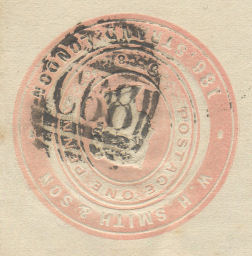
C68 was used by the London & Dover T.P.O. from 1865
I have examples dated 21/2/66, 3/8/66 and 15/7/71.
Brumell wrote (Pg39) when referring to 1857 onwards "When a stamp requires alteration or repair its place is often taken temporarily by a stamp, either of steel or rubber, fitted up with moveable type; such stamps are called Travelling stamps and are kept at Head offices in readiness for use at any sub-office as required." Perhaps T.O. stands for 'Travelling Obliterator',
but could just as easily stand for 'Transit Office'.
In 'The Postage Stamps of Great Britain (part 1, 3rd Edn. 1967,Pg 90) J.B.Seymour and Clive Gardiner-Hill write "Charles Williams was informed officially that these cancellations, which are uncommon, may have been issued for use on ship or naval letters, or both, passing through the Circulation Department. All Royal Navy letters would go to St Martin's le Grand for re-direction." This would be consistent with the T.O. standing for 'Transit Office'. But in that case, it is difficult to understand how the T.O.3 cover shown below made it from the Atlantic to St Martin's le Grand before being cancelled.
Another theory is that it was a precancel, which is why they have a page on this website. The T.O. obliterators shown above were issued in 1860, five years before Smith, Elder & Co received their obliterator. It is quite possible that the requirement of a precancel or something similar was anticipated, and that the T.O. perhaps stood for 'Temporary Obliterator'. If so then at least some of the series would seem to have been used by W. H. Smith & Son prior to receiving their own precancel obliterators, and continued in use afterwards. However there is evidence given below that T.O.1, T.O.2, T.O.3 and T.O.6 at least were not precancels.
Since the whole point of a precancel is to speed up bulk mailings, it seems unlikely that the rare T.O.4 and T.O.5 would be precancels if the others are not!
On the left below is an image kindly provided by Tim Burgess showing an example of T.O.6 on a two pence embossed W. H. Smith wrapper dated 22/1/64 and on the right, I have an example of T.O.6 on a Smith, Elder & Co., one penny embossed dated 11/3/63:
The water is a little muddy though as it appears to have had 'gratis' written on the back, been gummed, stuck down and cancelled with 'T.O.6' then peeled off causing several patches of thinning (see around 'ON' of 'London').
Was Smith, Elder & Co in the habit of doing this sort of thing? It might be a way of currying favour with an important client while still getting the advertising, I do have another Smith, Elder & Co embossed that shows some evidence of gumming although without the 'gratis'. Alternatively it might be the result of an item from Smith, Elder & Co that passed through the post without being cancelled and was then re-used - see the 1906 example below: Unless though, it was sent to W. H. Smith & Son and used by them after dutifully precancelling with the 'T.O.6' cancel, it would seem that 'T.O.6' is not a precancel. A possibility is that an early collector glued it in an album and it was subsequently roughly removed (not sure about the 'gratis' though). The use of a Smith Elder & Co precancel on a Grindlay & Co 'Home News' advertising collar shown earlier (which shows no sign of re-use) also invites explanation as I could just as well argue that the 'S' cancellation was not a precancel!
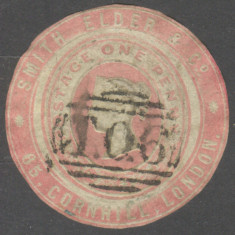
I do now have another example so it is not a one-off.
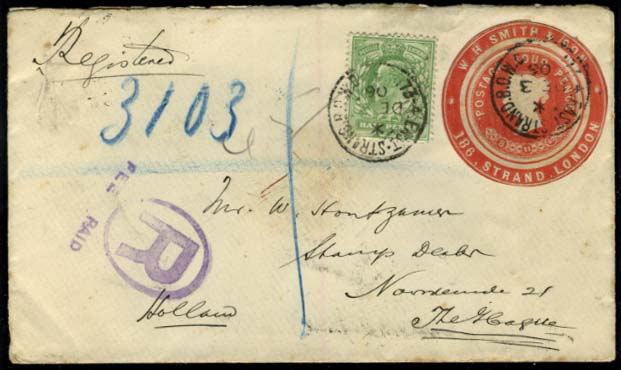
W. H. Smith & Son embossed and stuck on a 1906 Registered Cover. This one was stated to have an intact red seal with initials 'WH'. (eBay lot 380081612785)
It does have a postmark of East Strand that corresponds with the address on the collar. Image courtesy of Arthur-Ryan-GB-Stamps
If that was a bit unconvincing, I have a better example. Here we have 'T.O.2' on a 4d W. H. Smith embossed dated 30/9/72 and on a 1d Smith, Elder embossed dated 30/9/64.
As mentioned above and illustrated again here, the majority of my examples of the 1879 upright T.O.2 are on stamps with Dawson & Sons perfins.
I now have a couple of the 1860 type T.O.2 with a D&S perfin, so we have T.O.2 associated with three different companies.
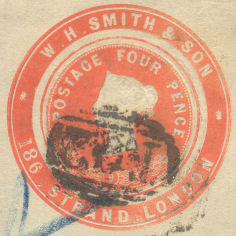 W.H.Smith & Son. |
 Smith, Elder & Co. |
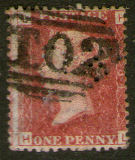 |
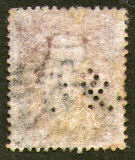
|
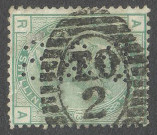 |
| D & S Dawson & Sons perfins. |
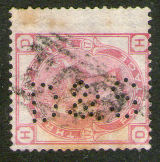 |
|||
| It certainly looks like T.O.2 was not a precancel. | ||||
This is the first T.O.1 cover I obtained, which fortuitously is quite early.
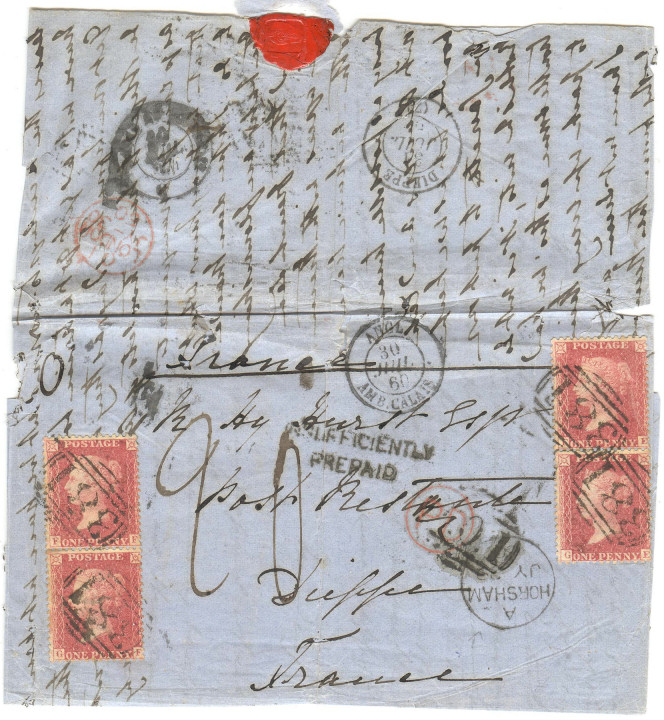
Horsham to Dieppe, France dated 29 July 1860, only 3 months after issue.
My second cover is nearly 4 years later:

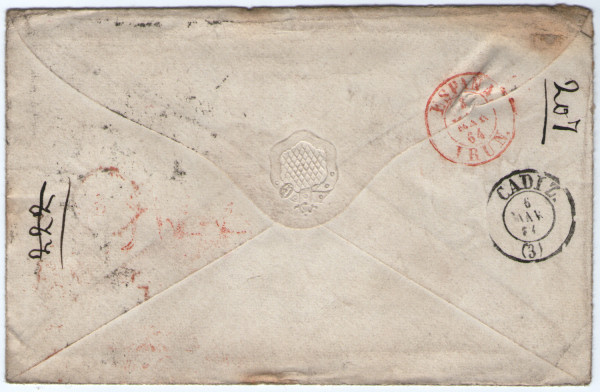
London NW9 to Cadiz, Spain dated 2 March 1864 with a 4d plate 4 (hairlines).
This one courtesy of Tim Burgess. Note the manuscript '6' (6d paid cash) and '40'.
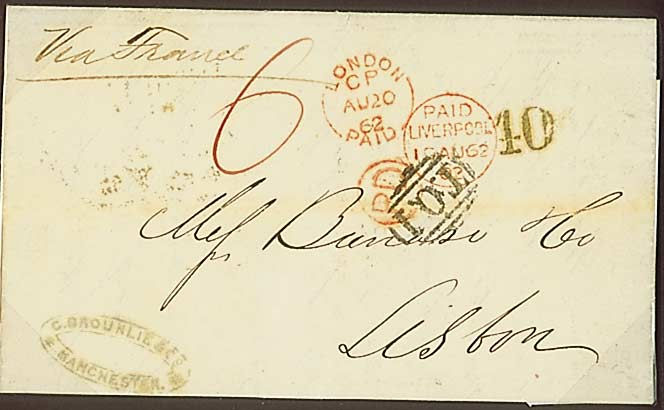
Liverpool to Lisbon on the coast of Portugal, via France 19 August 1862.
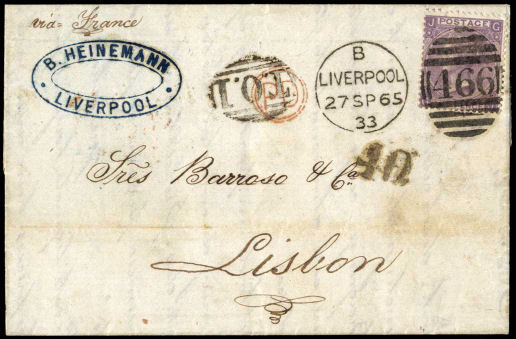
3 years later to the same address, and again from Liverpool (courtesy of Grosvenor Auctions), this time with a stamp and '40'.
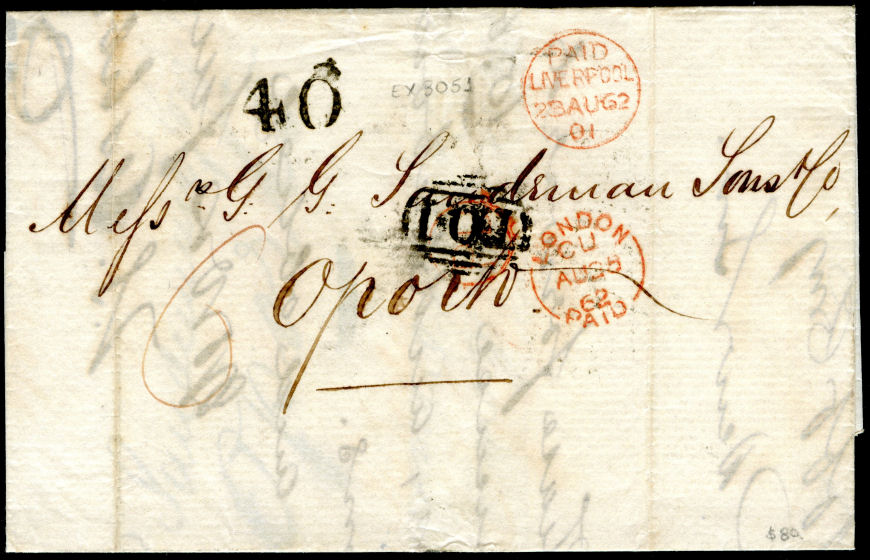
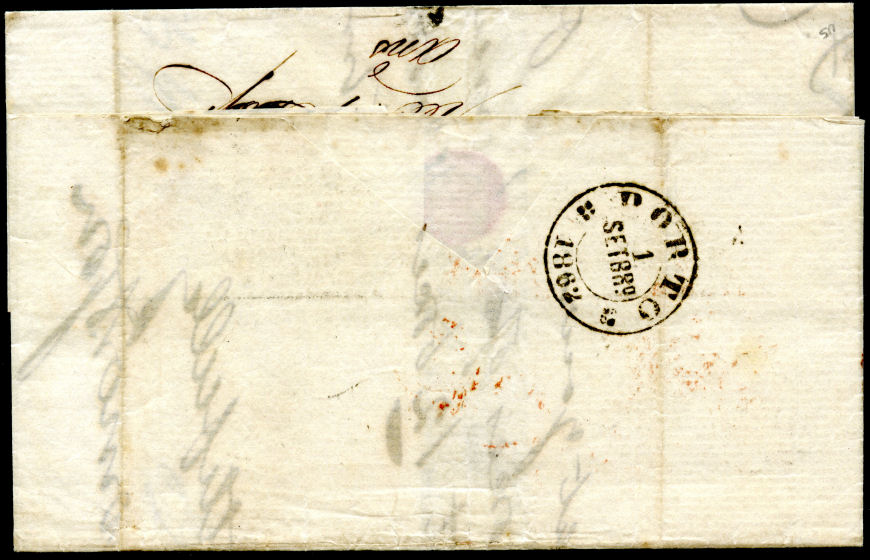
This one from Liverpool to Oporto on the coast of Portugal to the north of Lisbon dated August 1862. Front and back courtesy of Denis Mahon.
All three of these are from Liverpool to Portugal with 6d paid and with a T.O.1 cancelling the 'PD' mark (Paid to Destination).
They are without an "insufficiently Prepaid" mark, but have the same charge mark '40'.
The reason for this I am told is that until 31.07.1866 it was only possible to pre-pay the postage to the border of Portugal.
Postage within Portugal had to be paid locally since there was no postal agreements.
Thus the postage was correct, but the 'PD' marks were not
I have recently been shown another cover (see below) from Carlisle to Rome via France dated 1st. September 1864 with a 6d (plate 4) stamp.
It has an 'Insufficiently Prepaid' mark in black and a 'T.O.1' also in black on a red 'PD' mark.
This image comes courtesy of Julian Stray.

T.O. postmarks in red
Notice that none of these marks are on a stamp and the 'Insufficiently Prepaid' marks are in the same colour as the 'T.O.' marks.
The use of T.O.1 on covers rather than stamps would seem to imply that T.O.1 was not a precancel.
There is also a picture of a 'T.O.2' mark in reddish (looks like a bit of a mixture) on a penny red acquired indirectly from Tim Burgess.
The cover below also uses the same combination of Red 'Insufficiently Prepaid' mark, and a Red '50' (Transit ?) mark.
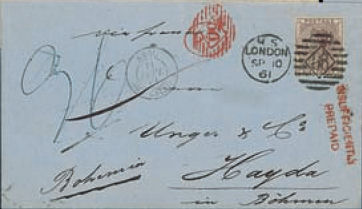
London to Hayda, Bohemia via France, September 1861.
The next cover of 28th March 1862 has a red '50 in diamond' (on PD) but a black 'Insufficiently Prepaid' mark.
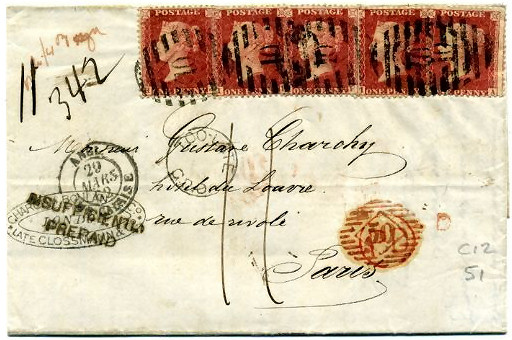

Is this because it was 'TOO LATE' ? - Image courtesy of Andrew Chappell of QV Pennies.
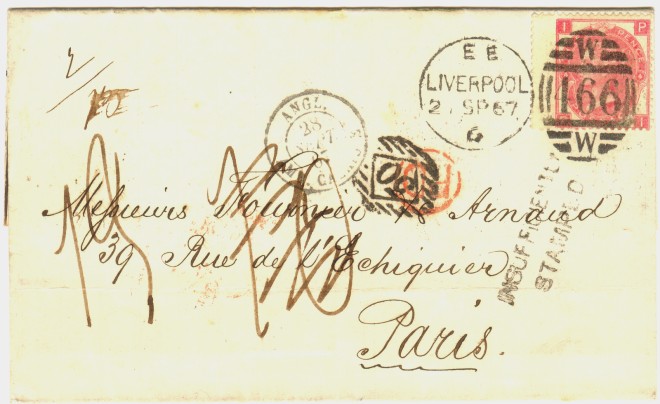
A September 1867 cover from Liverpool to Paris via London (backstamp) marked "INSUFFICIENTLY STAMPED" and '50' in diamond cancelling the 'PD' mark, both in black.
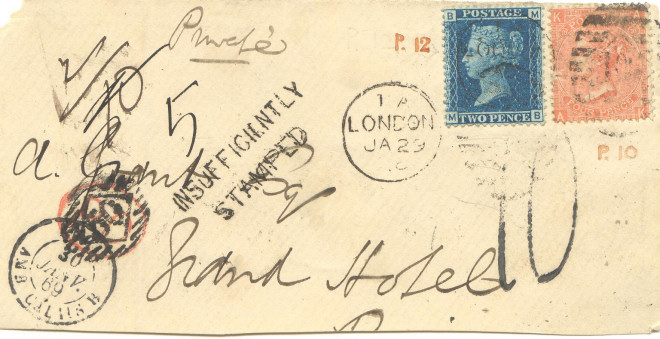
Part of a front from London to somewhere but with a Calais transit mark dated 30 Jan 69. This is marked "INSUFFICIENTLY STAMPED" and has a '50' in diamond cancelling the 'PD' mark.
All five of these covers have the 'Transit?' mark over the 'PD' (Paid to Destination) mark.
I would imagine that the 'PD' mark is applied in Britain by the postal clerk, believing that the postage was sufficient.
The T.O. or '50' mark is then used to cancel the 'PD' mark when found to be incorrect by someone better informed, or perhaps with more up-to-date information.
It may be that many of these were applied shortly after a change in the postage rates.
It has to be said however that the T.O. marks on stationary cut-outs do not have 'PD' marks on them though such marks could have been on the cover. I have a T.O on 'PD' on stamp though.
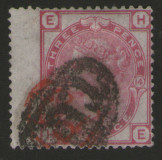
Number 50 was first introduced in May 1855 and according to G. Brumell, the number 50 was initially used by the 'Chief office of the London District' but by 1887 was in use by the Victoria Docks.
H. C. Westley says 50 was allocated to 'Chief Letter Carrier' on 20/5/44 and to Victoria Docks 20/4/83.
So at the time of these, the 50 would seem to indicate the London Chief Office.
Why did the last two get '50' in diamond rather than a T.O.1 cancel? Perhaps it was applied by an inspector if missed by the regular staff.
Were the other T.O. marks issued to other places to fulfil the same function as the '50' in diamond by other inspectors ?
This cover might give us a clue.
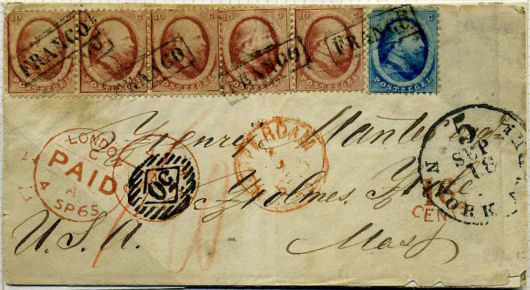
Sent from Rotterdam 2nd Sept. 1865, it arrived at London on the 4th receiving a red PAID mark and black '50' in diamond (no 'Insufficiently Prepaid' mark).
It then went on a Packet Boat (mark under the black '50' in diamond, red indicating morning) still on the 4th, arriving New York U.S.A. on the 18th.
Or did it go on the Packet Boat? is the '50' in diamond intended to cancel that mark as the one above cancels the 'PD' mark?
It is worth mentioning that I have seen a comment about a similar cancel with '29' in diamond being "temporarily loaned to P&O Line Mailboat".
I do not know when this was, but possibly the T.O. series represents a more permanent arrangement.
It seems more likely though that the allocation of A80-A90, A99, B03, B12, B16, B56, B57 and C79 to P&O Line Mailboats
and A91-98, B61 and B62 to Cunard Line Mailboats was the more permanent arrangement.
The '16 Cents' in red is interesting, I thought at first it was an American marking, but according to Hendy it is a transit charge on items bound for the U.S.A. passing through the U. K.
(Under article XII of an 1848 convention). He lists it under 'Foreign Branch'.
Incidentally, the Packet Boat mark has 'N' in the centre, Hendy lists 'L' for Liverpool and 'D' for Devonport, was 'N' for New York ?
The cover below, again courtesy of Tim Burgess has an 1866 6d stamp (emblems plate 5) and an August 27th. 1866 London PAID mark.
It also was the first T.O.3 example I knew of. The address includes "England", so must have been from outside England.
However, somewhere with 6d stamps, and they did seem to be available on the ships.

The back of the cover above, courtesy of Colin Hanson.
This is the only example of a T.O.6 on cover that I have seen.
It was sent from Gibraltar on 1st. October 1868 with manuscript equests to be sent “Per first Steamer / via England” to a company in Arnheim, Holland.
It bears a cachet of Ferdinand Schott, Gibraltar, and a red PD mark cancelled with black T.O.6 on the front.
The back has a red London Ship-Letter mark of 10 October 1868 and what looks like a London mark of 11 October 1868.
Image courtesy of Eric Holmes of The Gibraltar Study Circle.

This cover from London to Dunkerque, dated 14 April 1874 (near the end of the T.O.1 period) has what looks like an inspectors mark in the rôle of the T.O.1 cancelling a 'PD' mark.
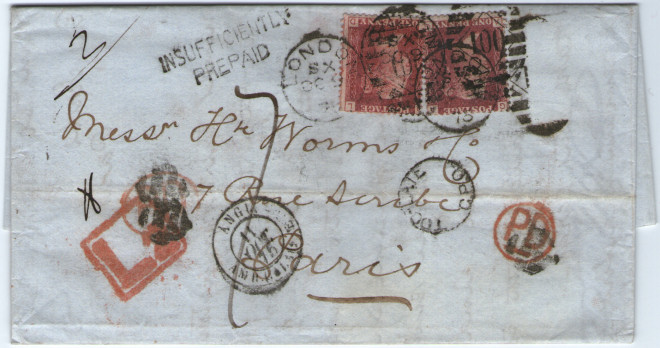
This cover from London to Paris, dated 9 October 1875 has 2 'PD' marks (one circular, one elliptical), a couple of 'Late' marks and a missing stamp.
It also has what looks like 3 inspectors marks cancelling the 'PD' markss
A note on Queenstown: Queenstown was an Irish port in County Cork, near Cork, and was originally known as Cove until Queen Victoria paid a visit in about 1867. In her honour it was renamed Queenstown. When that part of Ireland became independent in 1922, the name reverted to Cove but adopted the Gaelic spelling of Cobh, which is still pronounced Cove!
T.O.2 and T.O.6 ? I do not know, but I note that I have both of these used by Smith, Elder and I have no T.O.1 used by Smith, Elder.
Smith, Elder sent a lot of mail to India and Australia, perhaps this is a clue. Grindlay acted as Bankers and Agents in India also.
My understanding is that mail for both these destinations would have been taken from Southampton via Alexandria by P&O.
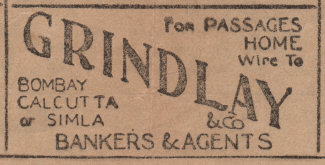
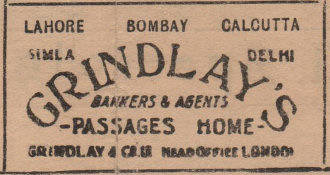
In the 1920's advertisements were to be found on the backs of telegrams in India. T.0.1 on 5/- stamps may reflect bulk sendings.
I also note that on Stationery, T.O.6 is about twice as common as T.O.2 but on loose stamps T.O.2 is about 10 times more common than T.O.6 !
This suggests that T.O.6 is associated with more commercial mail (WHS at least), but a lot less personal mail than T.O.2
Because of the levels if English literacy in the general populations, to me this suggests that T.O.6 is more likely to be on mail to India/Australia via Southampton.
The only perfinned example I have seen of the 1860 series is a T.O.2 with Dawson and Sons perfin.
Also the 1879 series of upright T.O.2 is strongly associated with Dawson and Sons.
Dawson and Sons precancels are found on a wide variety of face-value stamps.
One other clue, Tim Burgess' website shows 9 examples of the T.O. postmarks of which at least 6 are T.O.2 and none are T.O.6
His collection was put together in the USA.
To me, that suggests that T.O.2 is associated with mail bound for the Americas via Liverpool.
That leaves T.O.4 and T.O.5
The other main routes for foreign mail at this time (1860-75) were via Hull (to Bergen, Gothenburg, Copenhagen, Hamburg, Rotterdam and Antwerp),
and via Plymouth/Devonport to/from Capetown and from West Indies after October 1867.
You might think of Bristol, Falmouth and Milford Haven also, but as far as I can ascertain they were little involved with foreign packets during this period.
They would however have received ship-letters carried by private vessels.
It should be noted though, that control of the packet stations was in the hands of the Admiralty from 1837 until 1860, the same year that the T.O. series was issued. Coincidence ?
| T.O.1 | Dover |
| T.O.2 | Liverpool |
| T.O.3 | Queenstown / Dublin / Holyhead |
| T.O.4 | Devonport / Plymouth * |
| T.O.5 | Hull |
| T.O.6 | Southampton |
* Devonport up until 1870, then Plymouth.
One thing this does not explain is why the 1879 and later types only appear to exist as T.O.2 ! Despite the fact that the 1893 examples are to Switzerland and Gibraltar.
The only possibility I can think of is that All of the 1860 types were replaced with the same mark and T.O.2 was chosen as it was the one that was most used at the time.
So perhaps the table should be revised as :
| T.O.1 | Liverpool |
| T.O.2 | Dover |
| T.O.3 | Queenstown / Dublin / Holyhead |
| T.O.4 | Devonport / Plymouth * |
| T.O.5 | Hull |
| T.O.6 | Southampton |
It is worth emphasizing that I have seen no T.O. examples definitely used after 1874 until the new 1879 type, despite 10 examples from 1870 to 1874.
The only candidate I have is a penny red plate 154 (Put to press 30 Jan 72, destroyed 8 Jan 76).
Considering this decline in use, it would be surprising for a new type to be issued unless it was due to some change in its' purpose,
possibly as a result of the formation of the G.P.U. in 1874 and Britain joining in 1875. The G.P.U. was renamed the UPU on 1 January 1879.
As an aside, I would like to show this item:
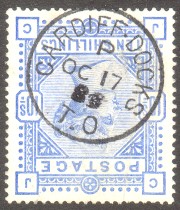
This 'T.O' at Cardiff Docks is for 'Telegraph Office'. Other examples are shown below.
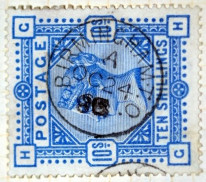

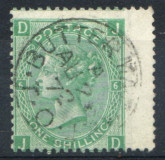
-----
At this point, I will draw a parallel with another series of postmarks issued 20 September 1865 that are little understood:
Note this is about the same time that the first precancels were issued (to Smith, Elder & Co.)
Obliterations like these with the letters 'B', 'F', 'H' and 'P' were issued to the Foreign Office. As usual, we are left guessing as to the intended purpose but they were in use at least up to 1884.
Theory 1. H. C. Westley considers that since J. G. Hendy says the principle ports for Ship-Letter arrivals at this time were Liverpool, Bristol, Falmouth, Plymouth and Hull
then it is reasonable to suppose they were intended to cancel Ship-Letters arriving at Bristol, Falmouth, Plymouth and Hull.
Liverpool was left out because it had a Ship Letter Office, it had pretty much taken over control of Ship Letters from Britain to the Western world, but I would be interested to know what their equivalent obliteration was.
Theory 2. F. H. Vallancey was aware of this theory and says "It seems probable however that the letters were those allotted to individual markers at the Foreign Branch."
If that is the case, then judging by their productivity, 'Barry' deserves the sack! But wait, if they sacked him they would have to place an advert -
"Wanted, postal workers at the Foreign Branch, only those with names beginning with 'B' need apply." or words to that effect !
In addition you would expect the same spread of face values for each letter. Below is a table of the few that I have:
| Letter | Quantity | Face values | Average |
| B | 1 | 3d | 3.0d |
| F | 7 | 1d, 2½d, 5d, 6d | 3.8d |
| H | 8 | 1d, 2d, 3d, 4d, 6d | 4.0d |
| P | 8 | 1d, 6d, 9d, 1s | 6.1d |
I have now also seen two examples of the 'P' on 5s stamps.
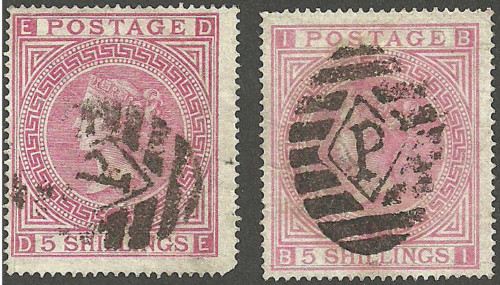
image courtesy of Cyclamon
Somehow I find the theory of H. C. Westley more convincing, I think that the letters stand for something with more permanence than postal workers.
The theory does have one weakness, according to J. G. Hendy, Bristol handled the most Ship Letters out of these four, but the 'B' obliteration is about the scarcest!
If that can be explained and Theory 1 really is correct, then what about the packet mail, what was their equivalent of the 'B', 'F', 'H' and 'P' obliterators ? The T.O. series perhaps.
It definitely seems that the P tends to be on higher face value stamps and is more common.
These marks are scarce on cover. I have seen few examples so far. This was posted to 'Bath, England'.
Considering that the postmark was issued to the Foreign
Office and bears a GB stamp, it is reasonable to suppose that it was posted at sea
and cancelled at Plymouth (or Portsmouth?) before going on to Bath, but there are other possibilities
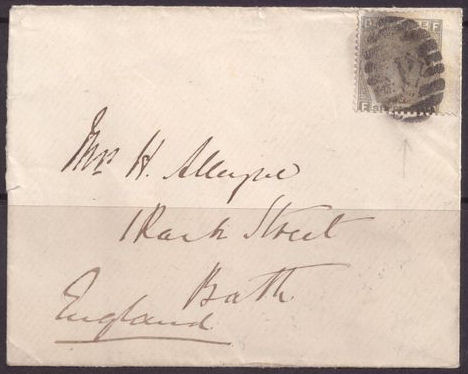
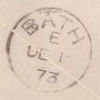
Images courtesy of Andrew Chappell (QV Pennies on eBay).
I have recently seen two covers, each with a pair of 1/- plate 4 stamps. One leaving Britain and one arriving in Britain, but both cancelled with a barred letter.
One was from Valparaiso to Stourport, Worcestershire, marked "via Panama" which arrived in London with the stamps previously uncancelled and were given Barred F cancels and a red London -E.C paid mark of 12 February 1866 .
The back has a Valparaiso date stamp for January 2 1866 and a partial Stourport cds for February 13th 1866.
The other was to Chile with only Barred P cancels on the stamps, but a red Lombard Street London Paid November 16th 1865 cds below them and a black Panama date stamp for December 10th 1865.
The two covers below are very similar, both addressed to the same person in Ringwood, England., and bearing 4d worth of British stamps.
They are both cancelled with 'F' suggesting that the 'F' was applied at a port of entry rather than randomly selected out of the 4 options at the Foreign Section.
They are dated 10/7/85 and 27/5/85 and one is marked "About Capt. Hutchinson" which may provide a clue regarding the port used.

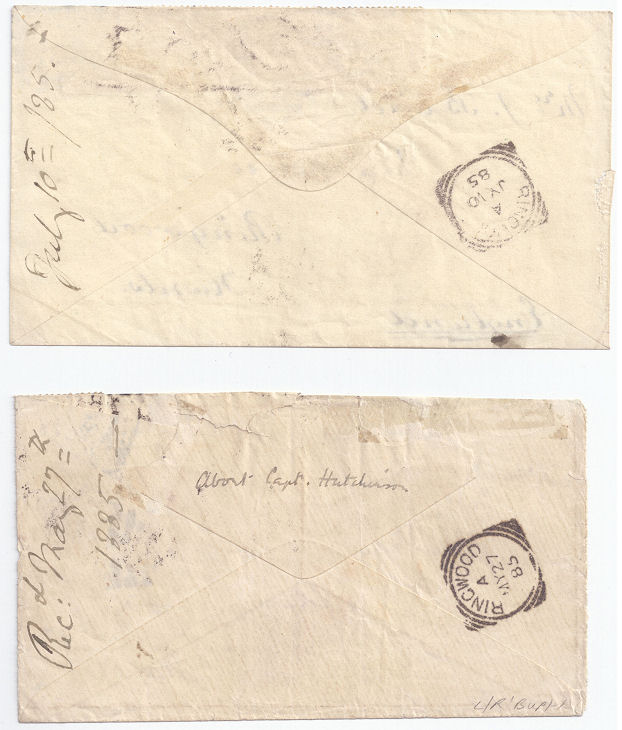
Images courtesy Andrew Chappell of QV Pennies.
This one is clearly leaving Britain
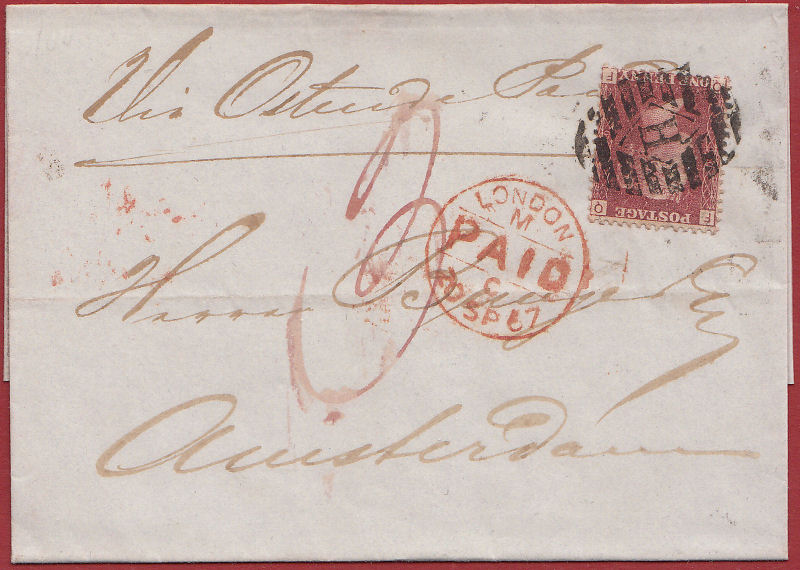
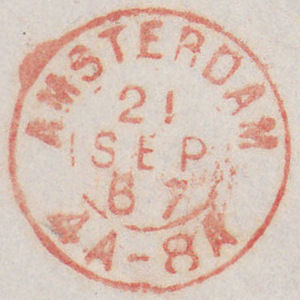
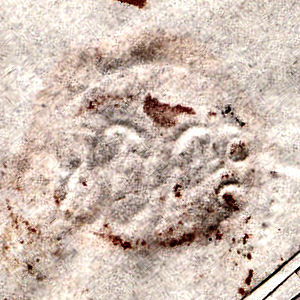
This was sent to Amsterdam via the 'Ostende Packet' and has a London Paid mark dated 20 September 1857,
together with an Amsterdam receiving mark of the following day on the back. It has a manuscript '3', with only a single 1d stamp.
An easy interpretation is that it was posted in London, but could it have been posted from outside the UK, receiving the 'H' mark,
Then having the Paid mark added when it got to London ? The back also has an embossed seal that I have enhanced. Anyone recognise the monogram?
Images courtesy of Peter J Markham (pjmgb) on eBay.
As a postscript, I recently saw this. It is almost certainly postal use of the 3/- telegraph stamp, but I am really curious as to what this cancel signifies.
Could this have been Southampton? If so, it should be a lot more common.
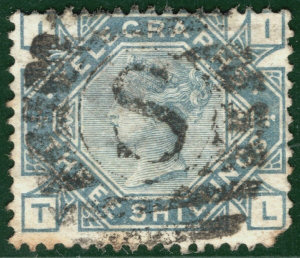
Anyone know anything about this ?
Image courtesy of Samwells Ltd.
click image for eBay listing.
Note: These should not be confused with the series below using smaller letters A, B, C and D thought to have been used for non-postal purposes and usually found on penny stamps.
Valency says these were "undoubtedly used at London Central Office."


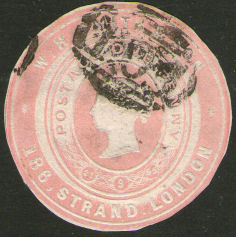
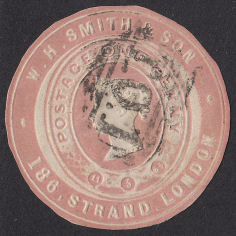
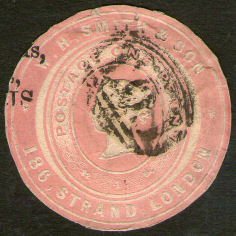
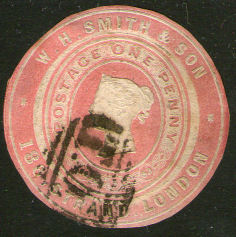
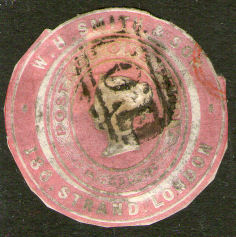
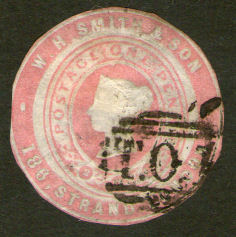
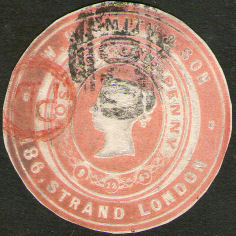

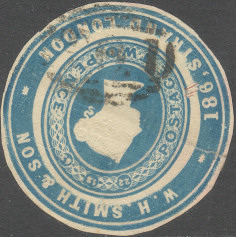

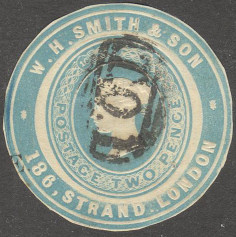
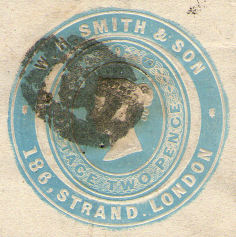
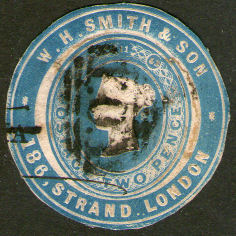
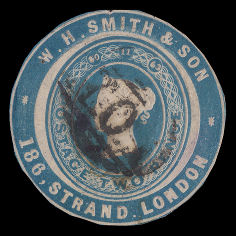
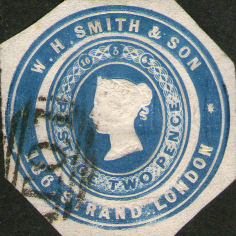
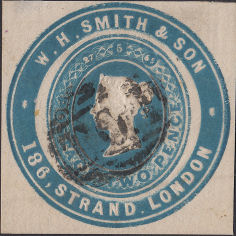
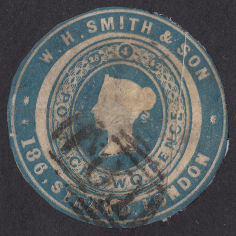
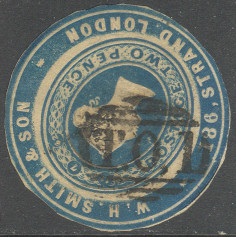

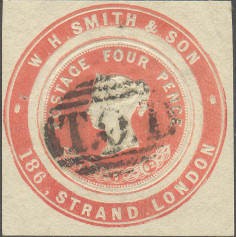
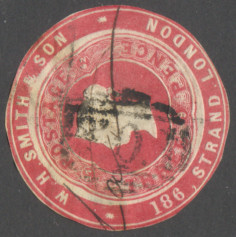
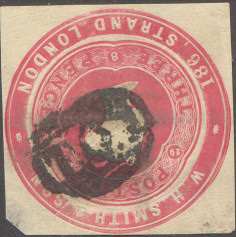
Interestingly, the last-but-one 2d and the 4d above are both dated 11/7/62, both on thin paper with a clear impression on the reverse and were both obtained from the same source.
The last TO1 cancel on a 2d is dated 31-05-69 and comes courtesy of Stephen Teuma.
The last TO6 cancel on a 2d is dated 31-08-69 and comes courtesy of Stephen Teuma.
 |
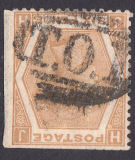 |
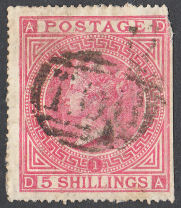 |
| 6d Plate 8 | 6d Plate 11 | Plate 1. This is the highest value I have seen a T.O on. |
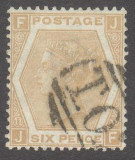 |
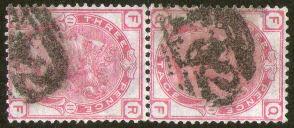 |
 |
| Plate 11 | Pair of 3d plate 11 | 3d plate 17, perfinned |
| T.O.3 | T.O.3 | T.O.4 | T.O.5 | T.O.5 |
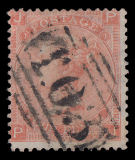 |
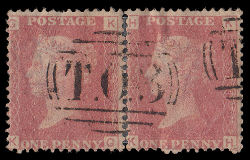 |
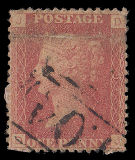 |
 |
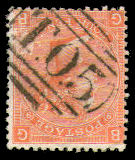 |
| 4d Plate 7 | 1d Plate 85 | 1d Plate 91 | 1d Plate 96 | 4d Plate 9 (inv) |
| T.O.6 on stars | T.O.6 | T.O.6 | T.O.6 | T.O.6 | T.O.6 on 2d |
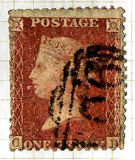 |
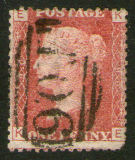 |
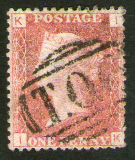 |
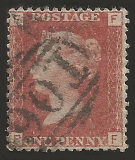 |
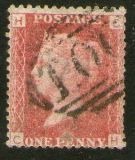 |
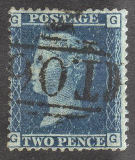 |
| Courtesy qvpennies | Plate 90 | Plate 95 | Plate 111, courtesy of Colin Hanson. | Plate 119 | Plate 9 |
The One Shilling stamp here is the only 1860 T.O. cancel I have seen on a shilling stamp (Courtesy of Tim Burgess)
On a light hearted note, the last one got my heart fluttering (sad I know), but with 4 bars top and bottom it clearly is not a T.O.5
Last updated 9th. December 2023
©Copyright Steve Panting 2010-2023 except where stated.
Permission is hereby granted to copy material for which the copyright is owned by myself, on condition that any data is not altered and this website is given credit.